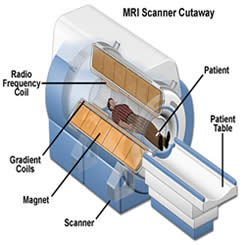Difference between CT scan and MRI
Key Difference: MRI (magnetic resonance imaging) scan is an imaging test that uses magnetic field and radio waves to detect structural abnormalities of the body whereas CT scan stands for Computed Tomography scan in which imaging method employs tomography. A CT scan is also known as CAT (Computer Axial Tomography).

MRI (magnetic resonance imaging) scan is an imaging test that uses magnetic field and radio waves to detect structural abnormalities of the body whereas CT scan stands for Computed Tomography scan in which imaging method employs tomography. A CT scan is also known as CAT (Computer Axial Tomography). In simple words a CT scan uses radiation whereas MRI uses magnetic field. A CT scan can be described as a sophisticated version of X-Ray scan. In CT scan numerous scans are taken from different angles. MRI exposes the body to a strong magnetic field and this procedure is capable of producing a detailed picture. However, they both are performed in a same manner; the patient needs to lie on a narrow table, which slides into a cylindrical machine. An MRI tends to take more time than a CT scan. Images obtained by MRI scans are of better quality and also provide versatility. One of the major benefits of using MRI scan rather than CT scans comes from the fact that an MRI scan does not use potential harmful radiations. This risk of exposure to harmful radiation is still present in conducting a CT scan. A person with metal implants, heart pacemakers, or metal chips or clips in or around the eyes is eligible for CT scan whereas MRI is not at all possible with such patients.
A CT scan is not useful to see tendons and ligaments whereas MRI is the perfect choice to obtain such images. This happens due to the density of tissues composing the tendons and ligaments. CT scan is preferred mode for cancer, pneumonia, and abnormal chest x-rays. Also, if bleeding occurs in brain due to some injury, then CT scan is preferred over MRI. CT scan shows organ tear and organ injury better than MRI. However, injury to the spinal cord is better displayed in MRI.
 In CT scan, x-ray beams are passed through the body part that needs to be imaged and these beams get collected by a detector. This detector converts these rays into electronic pulses and generates readings of the density of the tissue into a 1 cm slice of the body. From all these readings computer assembles a picture of the body and then this CT scan is viewed on fluorescent screen. This picture is photographed for later analysis and examination.
In CT scan, x-ray beams are passed through the body part that needs to be imaged and these beams get collected by a detector. This detector converts these rays into electronic pulses and generates readings of the density of the tissue into a 1 cm slice of the body. From all these readings computer assembles a picture of the body and then this CT scan is viewed on fluorescent screen. This picture is photographed for later analysis and examination.
MRI makes use of the fact that our body contains millions of hydrogen atoms. A strong magnetic field is used for the alignment of protons which reside inside hydrogen atoms. These protons get aligned parallel to the magnetic field. Pulses of radio waves are sent to the body and due to these radio waves the protons are knocked from their position. When the radio wave stops, these proteins are realigned into their place. And while doing this, they emit varied radio signals depending upon the body tissue. These signals are captured by a receiving device and then finally this device transmits the signals to a computer and based on these radio signals computer produces a picture. An MRI typically costs more than a CT scan.
Both these tests have been devised to locate or diagnose a medical problem. Both may be performed without use of contrast dye while MRI contrast dye gadolinium is regarded safer than CT contrast dyes like barium sulfate, gastrografin etc. CT scans were introduced before MRI scans and are preferred over MRI considering low cost involved in conducting CT scans. Thus the choice of using a CT scan or MRI depends upon the questions- what needs to be visualized and what is the reason for carrying out the test.
Image Courtesy: medtronic.com, mritechniciansite.com









Comments
Gross Jurry
Sat, 10/28/2017 - 15:40
James Prince
Thu, 10/26/2017 - 14:19
Ms.Mon
Sat, 11/18/2017 - 17:36
Calvin Arnold
Wed, 10/25/2017 - 15:39
Josh
Wed, 10/11/2017 - 11:35
Add new comment